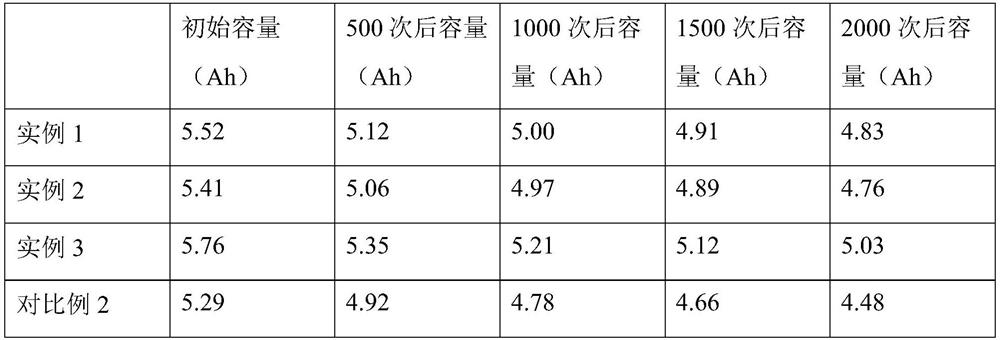Nano electrode material of energy storage lithium ion battery
A lithium-ion battery and nano-electrode technology, applied in battery electrodes, electrode manufacturing, secondary batteries, etc., can solve problems such as low conductivity and limited applications
- Summary
- Abstract
- Description
- Claims
- Application Information
AI Technical Summary
Problems solved by technology
Method used
Image
Examples
example 1
[0024] The nanometer electrode material for energy storage lithium ion battery is prepared by the following method:
[0025] Step 1) dissolving lithium carbonate in an aqueous solution of polyethylene glycol as a lithium source, stirring to form a solution, wherein the concentration of the lithium source is 0.5mol / L;
[0026] Step 2) Dissolving tetrabutyl titanate as a titanium source in an aqueous solution of polyethylene glycol and stirring to form a solution, wherein the concentration of the lithium source is 0.6 mol / L;
[0027] Step 3) adding carbon nanotubes to a mixed solution of acetic acid and nitric acid, in the mixed solution of acetic acid and nitric acid, the concentration of nitric acid is 60wt.%, adjust the pH to 4, so that the concentration of carbon nanotubes is 10mg / mL, ultrasonic treatment for 2h , forming a suspension;
[0028] Step 4) Mix the solutions obtained in steps 1) and 2) in equal volumes, and continuously add the suspension obtained in step 3) dur...
example 2
[0033] The nanometer electrode material for energy storage lithium ion battery is prepared by the following method:
[0034] Step 1) dissolving lithium carbonate in an aqueous solution of polyethylene glycol as a lithium source, stirring to form a solution, wherein the concentration of the lithium source is 0.5mol / L;
[0035] Step 2) Dissolving tetrabutyl titanate as a titanium source in an aqueous solution of polyethylene glycol and stirring to form a solution, wherein the concentration of the lithium source is 0.6 mol / L;
[0036] Step 3) adding carbon nanotubes to a mixed solution of acetic acid and nitric acid, in the mixed solution of acetic acid and nitric acid, the concentration of nitric acid is 70wt.%, adjust the pH to 4.5, so that the concentration of carbon nanotubes is 10mg / mL, ultrasonic treatment for 2h , forming a suspension;
[0037] Step 4) Mix the solutions obtained in steps 1) and 2) in equal volumes, and continuously add the suspension obtained in step 3) d...
example 3
[0042] The nanometer electrode material for energy storage lithium ion battery is prepared by the following method:
[0043] Step 1) dissolving lithium carbonate in an aqueous solution of polyethylene glycol as a lithium source, stirring to form a solution, wherein the concentration of the lithium source is 0.5mol / L;
[0044] Step 2) Dissolving tetrabutyl titanate as a titanium source in an aqueous solution of polyethylene glycol and stirring to form a solution, wherein the concentration of the lithium source is 0.6 mol / L;
[0045] Step 3) adding carbon nanotubes to a mixed solution of acetic acid and nitric acid, in the mixed solution of acetic acid and nitric acid, the concentration of nitric acid is 65wt.%, adjust the pH to 4.5, so that the concentration of carbon nanotubes is 10mg / mL, ultrasonic treatment for 2h , forming a suspension;
[0046] Step 4) Mix the solutions obtained in steps 1) and 2) in equal volumes, and continuously add the suspension obtained in step 3) d...
PUM
| Property | Measurement | Unit |
|---|---|---|
| concentration | aaaaa | aaaaa |
Abstract
Description
Claims
Application Information
 Login to View More
Login to View More - R&D
- Intellectual Property
- Life Sciences
- Materials
- Tech Scout
- Unparalleled Data Quality
- Higher Quality Content
- 60% Fewer Hallucinations
Browse by: Latest US Patents, China's latest patents, Technical Efficacy Thesaurus, Application Domain, Technology Topic, Popular Technical Reports.
© 2025 PatSnap. All rights reserved.Legal|Privacy policy|Modern Slavery Act Transparency Statement|Sitemap|About US| Contact US: help@patsnap.com



